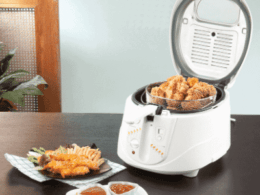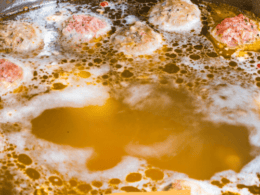Every type of pasta has a tendency to stick together when it hits hot water, but the problem with lasagne sheets is that it’s so much bigger than regular pasta, so that glue-y texture becomes a bigger issue because there’s more area to stick with other sheets. You can pull apart a penne pretty easily, but lasagne? Forget about it! So, how do you prevent lasagne sheets from sticking the next time you come to cook this delicious meal? Stick with us, and you’ll find out!

How to boil lasagne sheets without sticking
Surely boiling lasagne sheets will inevitably lead to them sticking? That’s what we said at the start, right? Whilst they are more likely to stick, it isn’t a guarantee, and by following these steps, you’ll be able to guarantee that they won’t!
Step 1
First, use a larger pot than you would usually. That’s because forcing lasagne sheets into a confined space is a sure-fire way to guarantee they’ll stick. Why? Because the pasta will hit the hot water and curl, when they do they’ll all curl together and those starches that are released when they hit hot water (the gluelike substance that seems to seep out of any pasta the moment it gets hot) will stick them together. Goodbye lasagne sheets, hello lasagne ball!
Step 2
Wait until the large pan is at a rolling boil and then add in some vegetable or olive oil. This helps to stop the lasagne sheets from sticking together by greasing them up slightly. It’s the same reason you add olive oil to a roasting tin when making roast potatoes. It just stops them from sticking. You’ll need a good glug of oil for your large pan too. Two tablespoons are about right to make sure there is enough residual oil leftover once you’ve drained the lasagne sheets.

Step 3
But we’re getting ahead of ourselves. Before you drain the pasta, you need to worry about cooking the pasta. One joy of any pasta is that you can stick it in a pan with boiling water and forget about it: but you can’t do that with lasagne! You’ll need to use a wooden spoon to continuously stir the pasta until it softens. Only after
it has softened are you safe to leave it alone, because you will have done your best to keep them separated whilst it releases the starches. Once it’s softened a little, those starches should have lessened and the sheets should be less glue-y (a technical term, we’re sure…), so you can leave it alone and let the oil you added earlier do the separating for you!
Step 4
Now back to draining. You’ll be happy to hear that this is the one stage you don’t need to change the way you usually do it. Drain your noodles as you usually would. Hopefully, none of them are stuck together at all, but if they are, just peel them away from one another. The oil should make this easier, and you shouldn’t end up with torn up lasagne sheets like you would if you hadn’t used the oil.
Why the big pot?
We thought we’d include this here because we’re certain some of you are wondering why you’ve gone to the trouble of digging out your largest pot to cook lasagne if you’ve just added oil to prevent sticking anyway. Well, the size of the pot still matters even with the oil in the water. That’s because the starch to water ratio can still be too high in a small pot, even if that small pot has oil in it. This means the water itself can work against you by taking on the properties of the sticky pasta starch that’s released when lasagne sheets are cooked. Without the big pot, you’re essentially cooking the lasagne in glue!
Prevent pre-cooked lasagne sheets from sticking
Can’t be bothered boiling your own lasagne sheets for fear of it sticking? Got a willing partner or family member who will do the initial cooking for you? That makes sense, you’ll probably get away with using pre-cooked lasagne sheets without needing to worry about them sticking, right? Sorry folks, it just doesn’t work like that. Precooked lasagne sheets are going to stick together too without the proper care, so if you’ve palmed the job of cooking the lasagne sheets off onto somebody else, then we’re afraid you’re still going to need this next section…
Sprinkle olive oil
Once you’ve cooked the pasta, one of the first things you’ll want to do is sprinkle a little olive oil over the individual sheets. We say a little, because depending on how much you put in the water when you cooked, there could still be a considerable amount left on the sheets. Look at your pasta closely. Is there still a slight sheen to them? You might not need any olive oil at all if that sheen is quite pronounced and they look as though you have already coated them in oil. If they need a little more to stop them from sticking, then go ahead, but use it sparingly.
Remember, too much oil can be a problem with lasagne sheets too, because it can really mess up the assembly of the dish. Too much oil, and the sauce and cheese won’t stick to it, so you won’t create the most delicious part of a lasagne – when the cheese, sauces, and lasagne sheets all work together as one complete unit after baking. So be careful with the amount of oil used.
TOP TIP: Consider using a spray bottle of olive oil instead. Two sprays on each sheet ought to stop them from sticking without making it so oily that the lasagne can’t be baked into the complete dish you’re looking for.
Use plastic foil
Plastic foil is another great alternative to storing pre-cooked lasagne sheets. By placing them on here, they don’t become easily stuck to the surface, so you can peel them away from the foil when you want to assemble your dish. In fact, the leftover oil from the cooking water ought to be enough to stop them from sticking at all. Just be careful about how you arrange them. Don’t let any sheets overlap or they might stick if you leave them to rest there for too long.
Place in cold water
Another great way to store lasagne sheets after you have cooked them is in cold water. Hot water brings out that glue like starch, ergo, cold water keeps it at bay. It’s simple really, and after using oil in the water to cook the pasta to begin with, you won’t need to add any more oil when you transfer the pasta into some cold water instead.
This has two benefits. The first is that it prevents the pasta sheets from sticking, and the second is that it gets the pasta nice and cold to handle it when you’re layering the lasagne or whatever dish you’re making with the lasagne sheets. It’s a win-win!
One final (unpopular?) tip…

OK. This last one is going to split the lasagne community like you wouldn’t believe, so imagine we’re whispering this one so we don’t get shouted down for the suggestion:
You can always place uncooked pasta in the lasagne dish and bake the whole thing for longer.
Will you probably end up with a few crispy bits here and there? Yes. Will it affect the texture of the dish overall? Maybe a little. But does it make your life a lot easier? You bet it does!
Now, if you’re a die-hard traditionalist, then we imagine you’ve just got a little heated after reading that, and that’s why we led with the whole cooking the pasta in oil and storing it correctly before assembly thing. But not everybody is a pasta aficionado, so sometimes a little cheat here and a sneaky trick there isn’t the end of the world.
Are you wondering how it works? It’s simple really, the sauces act as the hot liquid you’re cooking the lasagne sheets in. Instead of boiling water, the hot meat and cheese sauces cook the dried lasagne sheets until they are done. Obviously, the sauces aren’t at a rolling boil like the water is that you usually cook the lasagne sheets in, so you need to cook it for slightly longer. We suppose it’s a sort of ‘low ‘n’ slow’ lasagne when you cook it this way.
We’d also recommend putting a knife through the lasagne to make sure it’s cooked. Any crunches, and you’ll need to pop it back in for another 10 minutes. Try cooking lasagne at a moderate heat (around 200C or 370F) for 45 minutes to start with. If that doesn’t do it, check again after 10 minutes and it ought to be done. Crispy lasagne sheets be gone!
And remember, if anybody asks where you heard that tip – it wasn’t us!
Kitchen tools you’ll need
- GOTHAM STEEL 5-Quart Stock Pot
- Egg Lasagne sheets 500 g
- Organic Extra Virgin Olive Oil, Cold-Pressed
- 3-Piece Glass Casserole Baking Dish
Take-home message
Despite our above tip (shhh), we think it’s important to know how to prevent lasagne sheets from sticking because pre-cooking the sheets make for a much nicer lasagne. Remember to use a large pan, add oil to the water, and stir the pasta until it softens to prevent them from sticking together. Then either store them with an extra sprinkle of olive oil, on some plastic foil, or in some cold water until you’re ready to use them. Stick with this guide, and your lasagne sheets will never stick again!





